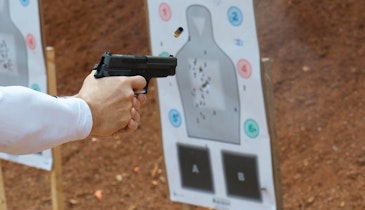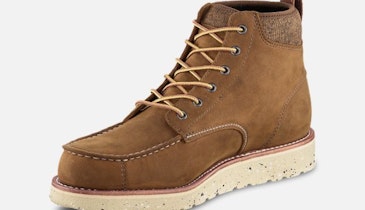After 10 years of workhorse reliability, the Stoeger M3000 shotgun line has received a facelift. It’s an ergonomic nip and tuck, to be honest. The changes are significant though, and as any good facelift should be, not immediately visible.
“It was time for an update,” says Keith Heinlein, Stoeger product manager. “I’ve been working on these for more than 18 months. It’s all ergonomics, involving the grip and a few other areas. The chassis, the internal guts, that’s all still the same. But it was time to work on some other things we believe are solid improvements.”
Stoeger is part of the Benelli USA family, along with Benelli and Franchi. This power trio covers the gamut of features on its shotguns and pistols across various price points. Benelli sits atop the line in price and features, with Franchi and Stoeger comfortably behind. Consumers have myriad options in each line to consider for their sporting and home defense shotguns. Variations of the inertia-driven technology found in Benelli’s top models, such as the Super Black Eagle line, are found throughout the lines and give retailers a range of options to consider.
Heinlein says the redesign “is for the entire line of M3020, M3000 and M3500 shotguns. The only guns that are not included in the redesign are those with a pistol grip or compact stock.”
Last December in Arkansas at Cypress Island Lodge south of Stuttgart, Heinlein and Fiocchi’s Travis Franklin, along with a crew of writers, put the redesigned M3000 to the test.
Added Touches
The Turkish-made Stoeger M3000 was introduced in 2012, nudging into the affordable shotgun category with ease and replacing the M2000.
Stoeger’s long history dates to the 1920s when Stoeger Industries was created by Alexander F. Stoeger. It became the largest gun store in New York City, and eventually began commissioning some European manufacturers to create shotguns for import. In the late 1980s, the Vursan arms company in Turkey created the first semi-automatic shotgun in the country. In 1989, Vursan entered into a partnership with Beretta Holding, and in 2002 it was purchased. Stoeger, via Vursan, became an affordable cog in Beretta’s family.
The M2000 shotgun had a run of about a decade before being replaced in 2012 by the M3000 series. For less than $600, shooters got a semi-automatic shotgun with reliable internal inertia technology. When the M3000 replaced the M2000, it included a shim kit for stock adjustments and was tapped for an optic. The rotating bolt was updated to match the existing M3500, which handled magnum ammo. Those were big updates at the time. Today’s model handles 3-inch magnum ammunition, comes with a shim kit for adjustments on drop and length-of-pull, and has options for barrel length. It is available with a synthetic or wood/blued setup.
After 10 years, it was time for some updating. It’s clearly established that Stoeger is the affordable workhorse of the Benelli family. Heinlein would’ve been crazy to ask his bosses to allow him to redesign or change internal components. That’s not going to happen for a $600 shotgun, and wouldn’t happen in any company’s lineup. Ferrari isn’t going to put its Daytona SP3 engine in its Portofino model. Yet it might add luxury touches from the Daytona in the Portofino, which drivers would notice and appreciate.
Stoeger’s long history has been about rugged dependability at a reasonable price. Nothing appears to have changed with the new M3000 updates.
Taking it Afield
Our crew arrived at Cypress Lodge hoping for a push of ducks and geese before Christmas. Despite water in the outfitter’s fields and nearby Bayou Meto, the birds were scattered. Unseasonable temperatures also hadn’t resulted in a big migration. Some seasons are tougher than others.
We got busy breaking down and cleaning the Stoeger M3000s, which were new and well protected by a layer of grease. Cleaning all this helps prevent malfunctions; none of our crew, far as I know, had any in-field issues with loading, firing or ejecting. A bit of Ballistol in key spots during reassembly kept things running smoothly. Heinlein explained some of the updates he worked on for 18 months.
“If you took this gun a couple of years ago and asked what I could improve on, and obviously that doesn’t mean the internals, I’d have said the ergonomics,” he said. “They have been known to run and run well, but were considered maybe a little blocky with not great ergonomics. But now the grip angle has been changed and is thinner. It has a new recoil pad and comb pad, and the foregrip is thinner. It has the bigger controls, too, the safety and bolt handle, which is standard on all our guns, and we changed the rear of the receiver to have more of a low profile.”
After comparing the M3000 to the M3500 that I purchased last year after a goose hunt, the new features are noticeable and appreciated. The oversized safety and bolt handle are great when you’re wearing gloves or focused on birds in the heat of a flurry. Feeding shells is smoother thanks to a beveled loading port. The end cap is slightly changed, too, for a better grip when removing or assembly.
I’d like to see more checkering on the foregrip. My hands are large and swallow the narrow grip, putting my fingertips and thumb on a smooth portion by the barrel. Shooters could remedy that with some stick-on abrasive tape, should they want it. But I like the trim design of the grip; when shouldering and swinging, the gun felt lighter than its 7.5 pounds. The grip angle — slightly more downward — feels quite comfortable with or without gloves.
Recoil was fine, too, as we killed mallards, gadwalls and other ducks along with a few snow geese with Fiocchi’s Flyway Series steel and Golden Waterfowl Bismuth, using T- and BB-shot for the geese. Heinlein said testing during the redesign showed the vented buttpad is more effective at absorbing felt recoil. Even with some over-the-blind “get that duck!” shots with a less-than-perfect shoulder, the gun didn’t batter anyone.
We all killed ducks and geese during our three days at Cypress Lodge, even after one night of rip-roaring thunder, rain and lighting on the upper edge of a tornadic line out of Louisiana. On our final outing the action was fast, furious and sustained until mid-morning, with decoy-workers, pass-shooting speedsters and even a ruddy that managed to slip into range. A single goose honking along looking for pals took a nosedive into the flooded buck brush after taking a pounding from the Fiocchi bismuth.
Your customers should have the same results: reliable dependability from an affordable shotgun with a long history of getting the job done.








